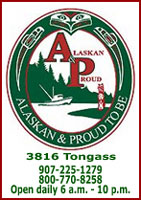
State-of-the-Art Analysis Reports No Fukushima-Related Radiation Detected in Alaska Seafood
January 11, 2017
The Alaska Department of Environmental Conservation (DEC), in conjunction with the Alaska Department of Health and Social Services and other state, federal, and international agencies, continues testing Alaska seafood for any potential impacts resulting from the 2011 Fukushima nuclear disaster in Japan. Testing performed in previous years showed no detectable levels of Fukushima-related radionuclides. Testing in 2016 also confirmed the quality and health of Alaska seafood has not been impacted by the Fukushima nuclear disaster. Fish species were chosen for testing based on their importance to subsistence, sport, and commercial fisheries and because they spend part of their life cycle in the western Pacific Ocean. These species include: king (Chinook) salmon, chum (dog) salmon, sockeye (red) salmon, pink salmon (humpies), halibut, pollock, sablefish, herring, and Pacific cod. Samples of fish were taken by DEC Environmental Health Officers during regular inspections of commercial fishing processors throughout the state. The results of testing conducted on Alaska fish in 2016 showed no detection of Fukushima-related radionuclides Iodine-131 (I-131), Cesium-134 (Cs-134), and Cesium-137 (Cs-137). Alaska was selected in 2016 as the first state test site for implementation of a field deployable gamma-ray analysis system to analyze fish for radionuclides. This unique pilot project was organized by the U.S. Food and Drug Administration (FDA), and the system was installed at DEC’s Environmental Health Laboratory in Anchorage. Fish samples are analyzed in-house at DEC’s laboratory, and digital data is transmitted to the FDA’s Winchester Engineering and Analytical Center in Winchester, Massachusetts, for interpretation and reporting. This collaborative effort provides Alaska with the capability to evaluate surveillance samples in-state for Fukushima radiation. Validation of this portable system will allow rapid on-site evaluation of environmental samples for gamma radiation contamination (exposure) anywhere in the U.S. and will enhance the country’s Food Emergency Response Network. The State of Alaska continues to collaborate with other government agencies and researchers monitoring the marine environment. Although researchers from Woods Hole Oceanographic Institution have recently detected ultra-low levels of Fukushima-related radiation in seawater samples taken from Tillamook Bay and Gold Beach in Oregon, these findings do not indicate a threat to Alaska waters or the safety of consuming marine fish. DEC, in cooperation with its partners, currently deems fish and shellfish from Alaska waters unaffected by the nuclear reactor damage in Japan. However, the public is cautioned to be aware that fish and shellfish are still subject to local toxins, such as those that cause paralytic shellfish poisoning. A presentation highlighting the efforts of the Fish Monitoring Program and radionuclide testing will be given on Wednesday, February 8 at 3:30pm at the 2017 Alaska Forum on the Environment in Anchorage, Alaska.
Editing by Mary Kauffman, SitNews
Source of News:
Representations of fact and opinions in comments posted are solely those of the individual posters and do not represent the opinions of Sitnews.
|
|||


